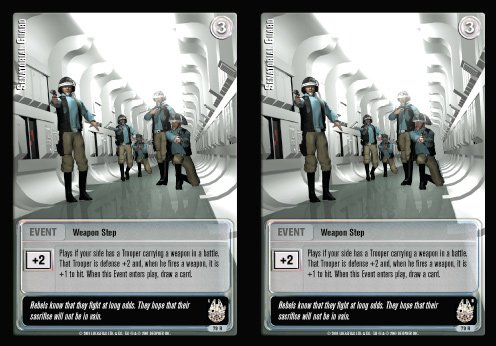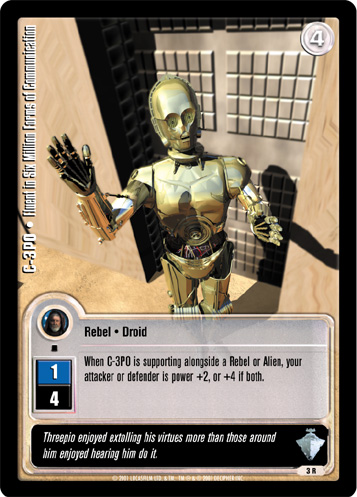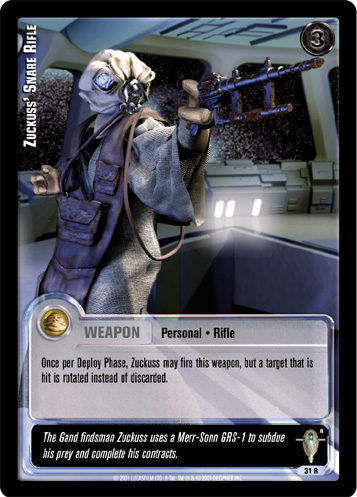Jedi Knights is centered around the classic trilogy (A New Hope, The Empire Strikes Back, and Return of the Jedi). Unlike its predecessor, the Star Wars CCG, expansions for Jedi Knights are connected with specific aspects of all three films rather than particular settings from each film taken separately. From the very release of the game its collectible nature was underlined by the existence of silver and gold foil cards, whose rarity was clearly specified by the publisher, and cards with "1st time in print" icon.

An example of the stereoscopic effect on a Jedi Knights card.
Jedi Knights cards do not contain images taken from the original movies, as it was for the Star Wars CCG. Instead, art is computer generated. One particular quality of the visuals in the game is that card arts often portray events and characters from the films from a perspective or angle that were absent in the film or depict situations mentioned but not shown in any of the three films. Additional value has been added to the cards by adding stereoscopic effect to certain designated cards. Another addition to classic card design were 'flip movie' cards, which contained arts taken from a continuity of images that, when viewed in a specific sequence, form an animated series . There were two of those 'movie' sequences: the opening scene from Star Wars: Episode IV A New Hope - Tantive IV being chased by Devastator and dogfight in the Death Star trench.

Jedi Knights computer-generated art often presents a different perspective or angle from those seen in the films.
Gameplay mechanics of Jedi Knights differ greatly from those present in previous Star Wars card games by Decipher, Inc., those being Star Wars CCG and Young Jedi Collectible Card Game. The goal of the game is to gain control over as many locations as possible while characters and starships battle one another on sites and planetary orbits. Unlike its predecessors, Jedi Knights does not have a clear-cut differentiation between "Light Side" and "Dark Side" decks, although certain cards can only be used by a particular side.
Each card has a Destiny number from 0 through 6 printed over allegiance icon: Light Side, Dark Side and Independent, the latter usable by either side of the conflict. Character and starship cards in Jedi Knights are distinguished by Power and Defense attributes, the first defining combat prowess and the second defining the ability to withstand weapon attacks. Each starship and character card (along with some of the weapon cards) has a deploy cost and some of them have leadership icons designating the ability to be supported in combat. Also, character, starship and weapon cards may have a certain theme color that influences deck design, although gray ('themeless') cards are also present.
Each deck needs a 'theme': a theme card and theme hero; those provided in the premiere release are: Han Solo (green theme color), Luke Skywalker (yellow), Grand Moff Wilhuff Tarkin (blue) and Darth Vader (red). The theme influences gameplay and deck construction by settling who goes first in the game and by favoring characters and items compatible with it, yet cards with different theme color are still usable.

Some Jedi Knights cards take their titles from respective Star Wars CCG cards, albeit their game texts differ.
The force deck specifies the amount of cards drawn by a player and serves as resource necessary to deploy characters, weapons and starships. The force deck includes eight force cards with numbers 1 through 8 which must be of one color (basic color released in premiere is green), although black wild cards are also available.
Combat is resolved on the basis of character and starship battles. The principle of drawing Destiny (drawing a card from deck and using the Destiny number printed on it) has been retained from Star Wars CCG, although the Destiny number applies solely to weapon targeting.
The game is played with the use of four double-sided cards presenting system/site locations (Tatooine, Bespin, Hoth and Endor) revealed one after the other, each turn taking place on different location. The main purpose of the game is control as many locations as possible. Control over a location is checked by tallying up total power of characters. The player with the greater total is considered 'in control' of a location. The game is won by one of the players when he or she control the majority of locations of the game.